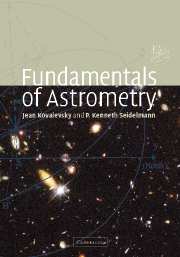Book contents
- Frontmatter
- Contents
- Preface
- List of abbreviations
- 1 Introduction
- 2 New observational techniques
- 3 Basic principles and coordinate systems
- 4 Treatment of astronomical data
- 5 Principles of relativity
- 6 Apparent displacements of celestial objects
- 7 Extragalactic reference frame
- 8 Dynamical reference frame
- 9 Terrestrial coordinate systems
- 10 Earth orientation
- 11 Stars
- 12 Double and multiple star systems
- 13 Astronomical phenomena
- 14 Applications to observations
- Appendix A Examples
- Appendix B Astronomical values
- Glossary
- References
- Index
2 - New observational techniques
Published online by Cambridge University Press: 05 November 2011
- Frontmatter
- Contents
- Preface
- List of abbreviations
- 1 Introduction
- 2 New observational techniques
- 3 Basic principles and coordinate systems
- 4 Treatment of astronomical data
- 5 Principles of relativity
- 6 Apparent displacements of celestial objects
- 7 Extragalactic reference frame
- 8 Dynamical reference frame
- 9 Terrestrial coordinate systems
- 10 Earth orientation
- 11 Stars
- 12 Double and multiple star systems
- 13 Astronomical phenomena
- 14 Applications to observations
- Appendix A Examples
- Appendix B Astronomical values
- Glossary
- References
- Index
Summary
What characterizes the new observational techniques is, of course, not only that they appeared recently – say in the past couple of decades – but also that they strive to reach one or two orders of magnitude better accuracy than the classical techniques. The unit for describing the new astrometric capabilities is no longer one tenth of a second of arc, but one thousandth of a second of arc, a subunit that we shall designate throughout this book by the abbreviation mas (milliarcsecond). Plans are underway to reach microarcsecond (μas) accuracies. Such a gain in precision impacts directly on all aspects of astronomy and, particularly, on the reduction procedures. One may divide these new techniques into three major groups: interferometry, timemeasuring techniques, and space astrometry.
New detectors
Many astrometric techniques take advantage of the development of much more sensitive new detectors. Among them, one must mention the following.
The CCD detector. The CCD (for charge coupled device) has become a major tool in astronomy since the 1970s (Monet, 1988). It consists of a semiconductor device, where a photoelectric effect takes place when light reaches it, producing an electronic image. This image is preserved by arrays of small positive electrodes, which attract photoelectrons and keep them in a similar array of potential wells, providing the possibility of long exposure times by adding photoelectrons in the same pack (Kovalevsky, 2002). […]
- Type
- Chapter
- Information
- Fundamentals of Astrometry , pp. 11 - 38Publisher: Cambridge University PressPrint publication year: 2004



